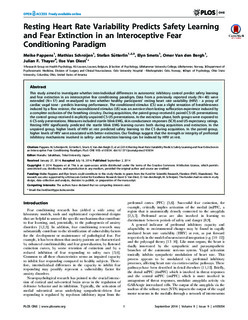Resting Heart Rate Variability Predicts Safety Learning and Fear Extinction in an Interoceptive Fear Conditioning Paradigm
Pappens, Meike; Schroijen, Mathias; Sütterlin, Stefan; Smets, Elyn; Van den Bergh, Omer; Thayer, Julian F.; Van Diest, Ilse
Journal article, Peer reviewed
Permanent lenke
http://hdl.handle.net/11250/275537Utgivelsesdato
2014Metadata
Vis full innførselSamlinger
Originalversjon
Pappens M, Schroijen M, Sütterlin S, Smets E, Van den Bergh O, Thayer JF, et al. (2014) Resting Heart Rate Variability Predicts Safety Learning and Fear Extinction in an Interoceptive Fear Conditioning Paradigm. PLoS ONE 9(9): e105054. 10.1371/journal.pone.0105054Sammendrag
This study aimed to investigate whether interindividual differences in autonomic inhibitory control predict safety learning and fear extinction in an interoceptive fear conditioning paradigm. Data from a previously reported study (N = 40) were extended (N = 17) and re-analyzed to test whether healthy participants’ resting heart rate variability (HRV) - a proxy of cardiac vagal tone - predicts learning performance. The conditioned stimulus (CS) was a slight sensation of breathlessness was an aversive short-lasting suffocation experience induced by a complete occlusion of the breathing circuitry. During acquisition, the paired group received 6 paired CS-US presentations; the control group received 6 explicitly unpaired CS-US presentations. In the extinction phase, both groups were exposed to 6 CS-only presentations. Measures included startle blink EMG, skin conductance responses (SCR) and US-expectancy ratings. Resting HRV significantly predicted the startle blink EMG learning curves both during acquisition and extinction. In the unpaired group, higher levels of HRV at rest predicted safety learning to the CS during acquisition. In the paired group, higher levels of HRV were associated with better extinction. Our findings suggest that the strength or integrity of prefrontal inhibitory mechanisms involved in safety- and extinction learning can be indexed by HRV at rest.
